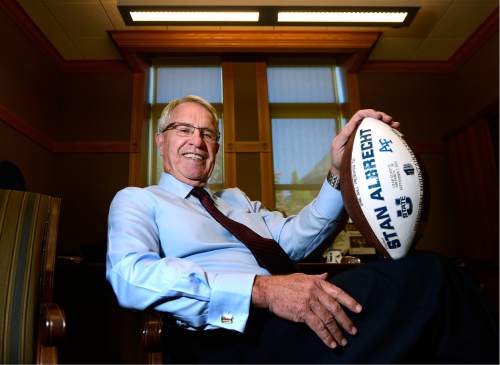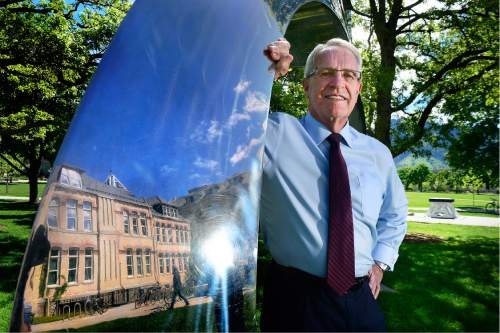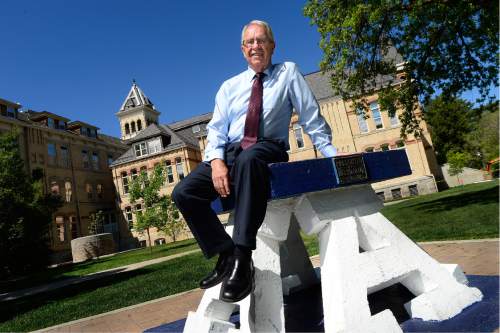This is an archived article that was published on sltrib.com in 2016, and information in the article may be outdated. It is provided only for personal research purposes and may not be reprinted.
Logan • Stan Albrecht's office is not exactly a shrine to athletics, but two keepsakes from his 11 years as president of Utah State University are proudly displayed.
One is a framed front page of The Salt Lake Tribune's sports section from Nov. 18, 2012.
The lead story and oversized photo — introduced by a headline that screams, "We are the champions" — details a 48-41 overtime win over Louisiana Tech which clinched the Western Athletic Conference title.
Below the Aggie coverage — tucked in the bottom corners of the page — are reports of Utah's loss to Arizona which cost the Utes a bowl bid and San Jose State's shocking 20-14 victory over BYU.
It was a special edition for Albrecht, who is retiring this year.
"I said to the Board of Trustees when we started this process that one of our goals was moving Utah State athletics from the fourth or fifth page to the front page," he explained.
Pointing to the framed newspaper, Albrecht added, "… That's why this was particularly rewarding. It epitomized what we were trying to do."
Also displayed in Albrecht's office is a football from the Aggies' 52-20 victory over Air Force on Sept, 7, 2013.
After years of a nomadic existence in college football's ever-changing landscape, the game was Utah State's first as a member of the Mountain West Conference.
Home sweet home.
"To go into the Mountain West and have that success against a really good institution with a really good football team, that was rewarding," Albrecht said. "… The team gave me the ball. That was a lot of fun."
Albrecht, who is retiring as Utah State's president this year, is leaving behind an unmatched athletics legacy. Under his watch, USU grew from a conference-wandering vagabond to its current status as a Mountain West mainstay. Hamstrung for years by by undernourished budgets and aging facilities, Albrecht has presided over a fundraising and facilities boom that includes a strength and conditioning center, a basketball/volleyball complex, an academic center, and, finally, a $36 million renovation of Maverik Stadium, scheduled to be completed in August.
Like the university's athletic program under his leadership, Albrecht has come a long way. Born 73 years ago on a farm in southern Utah, he played baseball and golf at little Wayne High School, mostly because "every guy had to be on a team or there wouldn't have been any teams."
An athletic-related highlight as a teenager?
"I grew up a Dodger fan," Albrecht said. "So when they moved from Brooklyn to Los Angeles, it was great because I could listen to Vin Scully every night on the radio."
Albrecht graduated from BYU in 1966. He did his post-grad work at Washington State and taught at Utah State and BYU before accepting a job at Florida. He returned to Utah State as a dean in 1998 and remembers attending a football game at pre-renovation Romney Stadium.
"… We were sitting on these old benches with a tiny crowd," Albrecht said. "The big event at halftime was the president sending out for M&Ms — peanut M&Ms. So we were passing around peanut M&Ms. Having sat in the president's box at the University of Florida, where football is a religion, I was thinking, 'There's a bit of a difference here.'"
When he was named Utah State's president in 2005, Albrecht was determined to improve the athletic program, within reason.
"We understand this is not Ohio State, Michigan, Southern Cal or the University of Florida," he said. "But this place has an incredible tradition athletically and anyone who has been around here understands there was a time when Utah State was the dominant institution in this state — particularly in football."
Albrecht shrugged slightly.
"Then a lot of things changed," he said.
Between 1960 and 1980, Utah State's football team had 14 winning seasons. But from 1981 and 2005, the Aggies went through seven head coaches. They had three winning seasons. They played in three different conferences, including the far-flung Sun Belt, in addition to spending two years as an independent.
"Utah State, in many ways, was left out," Albrecht said. "… We wandered in the wilderness for a number of years. And much of it was because we bounced around from place to place. So, very early on, we realized a number of things needed to be done as far as getting into the right conference."
The first obstacle to finding a stable home involved improving budgets and facilities. With the help of major donors, most notably Jim Laub, Utah State began a plan to move forward. It was rewarded with membership in the WAC.
"We were fortunate to have a few people who understood what was needed," Albrecht said. "I said to Jim several times, 'There were a lot of points along the way you could have walked away from us — maybe should have walked away.' But he didn't. He stayed with us."
Others joined the battle. Randy Spetman, followed by Scott Barnes, were high-energy athletic directors. Gary Andersen became the football coach and starting winning. Stew Morrill's successful basketball program helped maintain morale. Facilities were upgraded or newly built.
When Utah, BYU and TCU abandoned the Mountain West — followed by the WAC's collapse as a football conference — Utah State was well-positioned to fill the void.
"Once it became clear we couldn't rebuild the WAC — and we tried — it was essential to get into the Mountain West," Albrecht said. "We had no where else to go."
Commissioner Craig Thompson credits Albrecht.
"Stan's efforts, involvement and influence [was] priceless," he said. "He is a friend and confidant — someone you can completely and unilaterally trust. … I'm not saying Utah State wouldn't have gotten in without him, but he gets it. He thoroughly understands intercollegiate athletics."
Since 2013, Albrecht has also helped Utah State cement its place in the new league.
"On my visits to Logan, I always joke with Stan," Thompson said. "I tell him, 'There are so many construction cranes on campus, the state of Utah must be on hold because you've got them all. … What he's done just since joining the Mountain West is phenomenal."
Albrecht announced his retirement in February, although he won't leave until his successor is named. For now, he will continue to lead the university, knowing he has helped the athletic department not only survive, but prosper.
"We're situated right," Albrecht said. "This is the right conference with the right schools. It's the right geographic footprint. … If you look at the institutions, it's a natural place for us.
"Is it stable? Is it always going to be there for us? All I can tell you is we get inquiries every month from institutions that would like to come into the Mountain West."
Regarding whether he expects any current Mountain West members to leave soon, Albrecht said, "If the Big 12 came calling, the reality is we have some institutions that would jump at it. But I don't think that's going to happen."
Twitter: @sluhm —
The Stan Albrecht file
Position • President, Utah State University
Hometown • Fremont, Utah
Birthday • July 13, 1942
Colleges • Southern Utah, BYU, Washington State
Career highlights • Associate professor of sociology at Utah State (1970-74). … Professor and administrator at BYU (1974-1993). … Professor and administrator at Florida (1993-1998). … Dean of the College of Humanities, Arts and Social Sciences at Utah State (1998-2001). … Executive vice president and provost at Utah State (2001-2005). … President at Utah State (2005-2016). —
Aggies under Albrecht
A timeline of accomplishments for Utah State athletics since Stan Albrecht became school president:
2005 • Utah State joins the Western Athletic Conference
2008 • Construction completed on the 69,000-square foot Laub Athletic-Academic Complex, located in the north end zone of Maverik Stadium (then known as Romney Stadium)
2009 • Former Utah assistant Gary Andersen is hired as the new head football coach
2009 • Utah State wins the WAC men's basketball regular-season and tournament championships and qualifies for the NCAA Tournament
2010 • Utah State wins the WAC men's basketball regular-season championship and qualifies for the NCAA Tournament
2011 • Utah State wins the WAC men's basketball regular-season and tournament championships and qualifies for the NCAA Tournament
2012 • Utah State wins the WAC football championship, finishes 11-2 and begins a streak of five straight bowl appearances
2012 • A new artificial surface is installed in Maverik Stadium
2013 • Utah State joins the Mountain West Conference
2013 • Construction completed on the $6.5 million ICON Sports Performance Center
2013 • Under new coach Matt Wells, Utah State wins the Mountain West and defeats Northern Illinois, 21-14, in the Poinsettia Bowl
2014 • Construction completed on the $9.5 million Wayne Estes Center for basketball and volleyball
2016 • The $36 million renovation of Maverik Stadium is scheduled to be completed in August.









